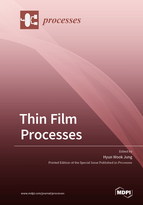Thin Film Processes
A special issue of Processes (ISSN 2227-9717). This special issue belongs to the section "Materials Processes".
Deadline for manuscript submissions: closed (31 March 2019) | Viewed by 44871
Special Issue Editor
Special Issue Information
Dear Colleagues,
Thin film processes are significantly incorporated in manufacturing displays, secondary batteries, fuel cells, solar cells, catalytic films, membranes, adhesives, and commodity films. Final properties of functionalized films are closely linked with applied processes, considering rheological aspects and process conditions. It is thus important to carefully scrutinize flow characteristics of materials in various processes for guaranteeing uniform and stable films.
This special issue on “Thin Film Processes” aims to address recent theoretical and experimental developments of thin film properties and related processes. Topics include, but are not limited to:
- Fundamentals of coating and drying processes
- Analysis of rheological processes (Film casting, film blowing, etc)
- Characterization of various properties of thin films (Crosslinking, rheological, and mechanical properties)
- Flow dynamics and stability in thin film processes
- General rheology of complex fluids
Prof. Dr. Hyun Wook Jung
Guest Editor
Manuscript Submission Information
Manuscripts should be submitted online at www.mdpi.com by registering and logging in to this website. Once you are registered, click here to go to the submission form. Manuscripts can be submitted until the deadline. All submissions that pass pre-check are peer-reviewed. Accepted papers will be published continuously in the journal (as soon as accepted) and will be listed together on the special issue website. Research articles, review articles as well as short communications are invited. For planned papers, a title and short abstract (about 100 words) can be sent to the Editorial Office for announcement on this website.
Submitted manuscripts should not have been published previously, nor be under consideration for publication elsewhere (except conference proceedings papers). All manuscripts are thoroughly refereed through a single-blind peer-review process. A guide for authors and other relevant information for submission of manuscripts is available on the Instructions for Authors page. Processes is an international peer-reviewed open access monthly journal published by MDPI.
Please visit the Instructions for Authors page before submitting a manuscript. The Article Processing Charge (APC) for publication in this open access journal is 2400 CHF (Swiss Francs). Submitted papers should be well formatted and use good English. Authors may use MDPI's English editing service prior to publication or during author revisions.
Keywords
- Film processes
- Coating and drying
- Rheology
- Stability
- Flow dynamics
- Property characterization
- Complex fluids






